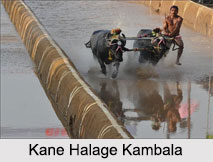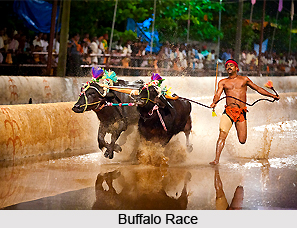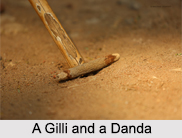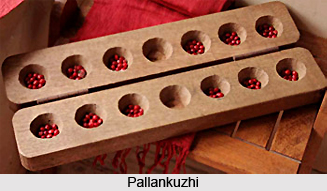 Kambala or Buffalo Race is a well-known sport in Karnataka. Following the age-old traditions today, Kambala is played as recreational sport by the farmers of Karnataka region. Kambala is played before the harvesting season begins. It is a way of showing gratitude to gods who protect their crops from destruction.
Kambala or Buffalo Race is a well-known sport in Karnataka. Following the age-old traditions today, Kambala is played as recreational sport by the farmers of Karnataka region. Kambala is played before the harvesting season begins. It is a way of showing gratitude to gods who protect their crops from destruction.
To celebrate Kambala, the farmers of Karnataka organize different kinds of outdoor sports. Kambala is also seen as the beginning of the sowing season for the next round of crops. Besides these, the sport is also organized during the religious festivals of the region, such as, Kodamantaya and Jumaadi Bhuta Kolas. Kambala season generally starts in November and lasts till March.
Legends of Kambala
It is difficult to trace the history of Kambala, yet it is popularly believed that Kambala is a sport festival that originated in the farming community of Karnataka around 800 years back. During the early days of the festival it was known as "Karaga" celebrations. It is a gesture of presenting thankfulness to the gods for good crops. It is a form of spare time sport for the farming community. According to another conviction, Kambala is considered as a sport of the royal (landlord) family of Dakshina Kannada and Udupi region of Karnataka.
Kambala festival is dedicated to Kadri`s Lord Manjunatha, a living form of Lord Shiva. According to legends, Kambala was started by the Hoysala Kings to watch if the buffaloes could be trained and used in war situations. Hoysala Kings were surprised to see the speed of the buffaloes and started to racing them against one another. As such, Kambala has developed as a sport for the royals.
Categories of Kambala
The contest generally takes place between the two pairs of buffaloes, each pair race in wet rice fields, controlled by a whip-lashing farmer. The celebration of "Bale" Kambala was suspended about 900 years ago. The Kambala which we see today is known as "Pookere" Kambala. Following are the different categories of Kambala:
•Negilu: In Negilu Kambala, a lighter plough is made especially which is tied to the buffaloes. This plough is just a representation of the real plough used in the fields. This is the entry stage of Kambala.
•Hagga: In Hagga Kambala, a rope is tied to the buffaloes. This category engrosses the buffaloes that are well experienced in taking part in the Kambala race.
•Adda Halage: In Adda Halage Kambala, horizontal wooden plank tied to the buffaloes and a farmer stands over it all throughout the race. This category is generally for the older buffaloes.
•Kane Halage: In Kane Halage Kambala, a rounded piece of wood is tied to buffaloes. Farmer stands on the wooden block on one leg. It has two holes throughout which water streams out while running. Height of the muddy water splashed will decide the winner. More the speed, more the height will be. This is the ultimate part of Kambala and most experienced buffaloes with the runners take part.
Celebration of Kambala
The celebration begins with an opening ceremony and a procession of the participating farmers along with their award-winning buffaloes. Soon after, the much-anticipated buffalo races set off. The `track` used for Kambala is a paddy field. Traditionally there used to be just one track but now 2 tracks are used for the race.
Earlier, the winning pair of buffaloes was rewarded with coconuts and bananas. Now, gold coins, silver coins are given, cash award is also given. The buffaloes developed for the contest are carefully fed and some vendors of the buffaloes even built a detached swimming pool for challenging the other buffaloes. The races go on all the night.
Supreme Court in 2014 had banned Kambala based on a petition filed by different animal rights organisations. On 3rd July 2017, Pranab Mukherjee, the President of India has legalized Kambala in Karnataka.



















